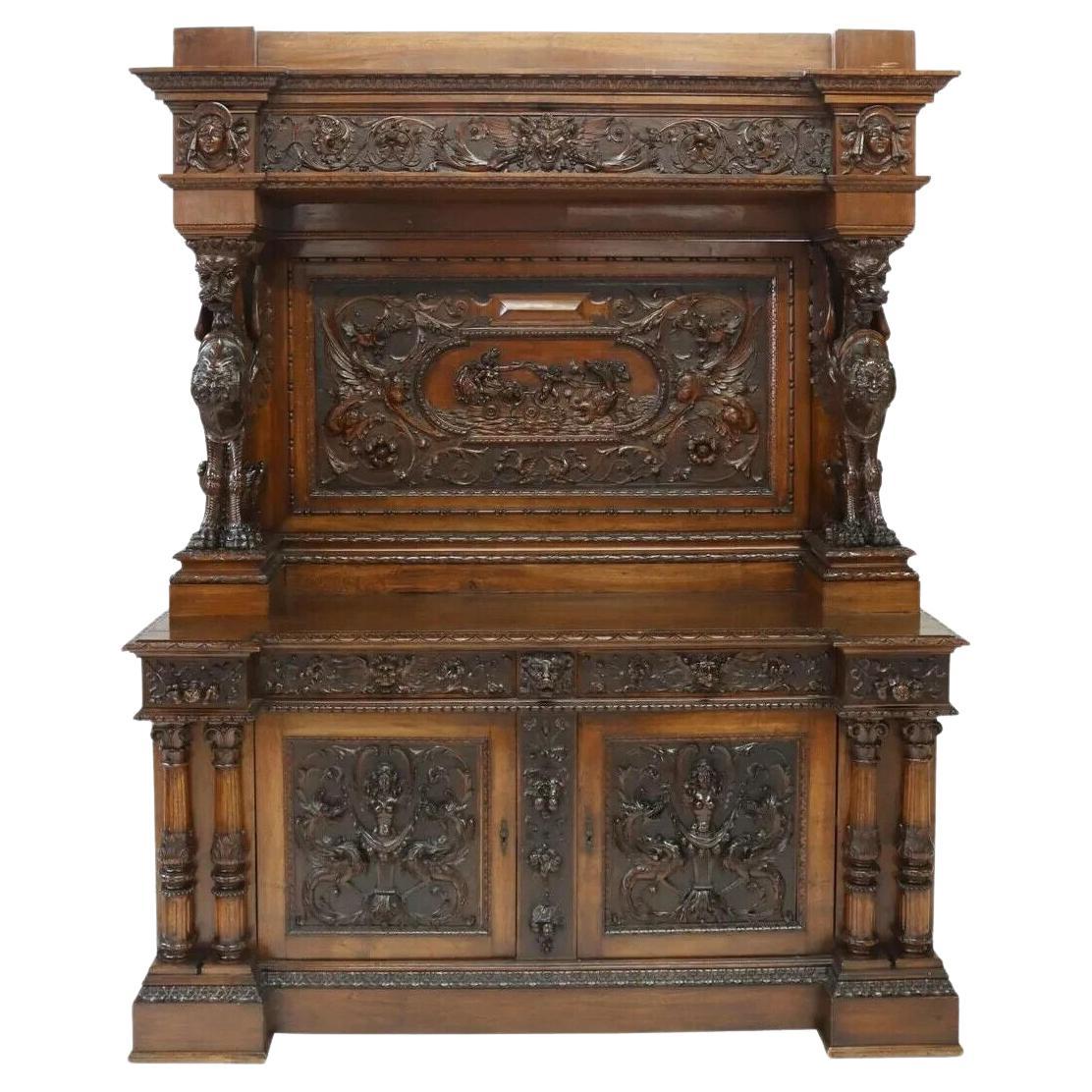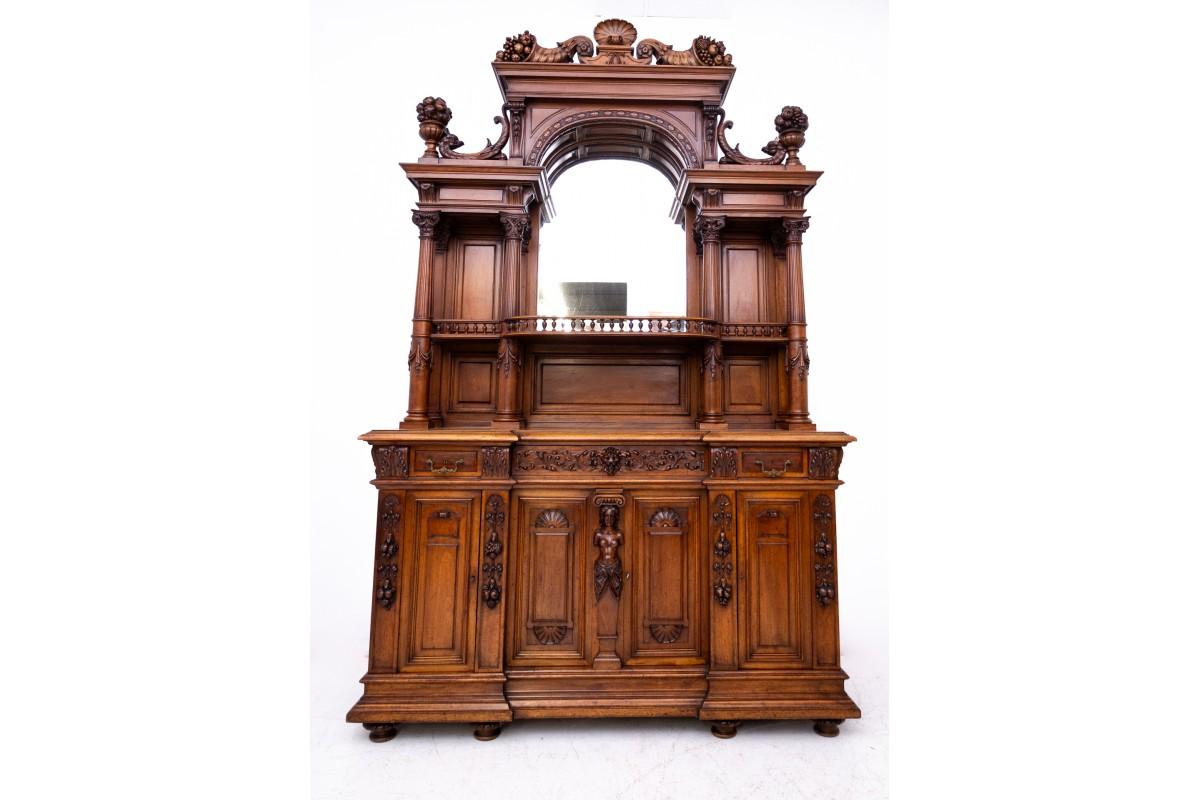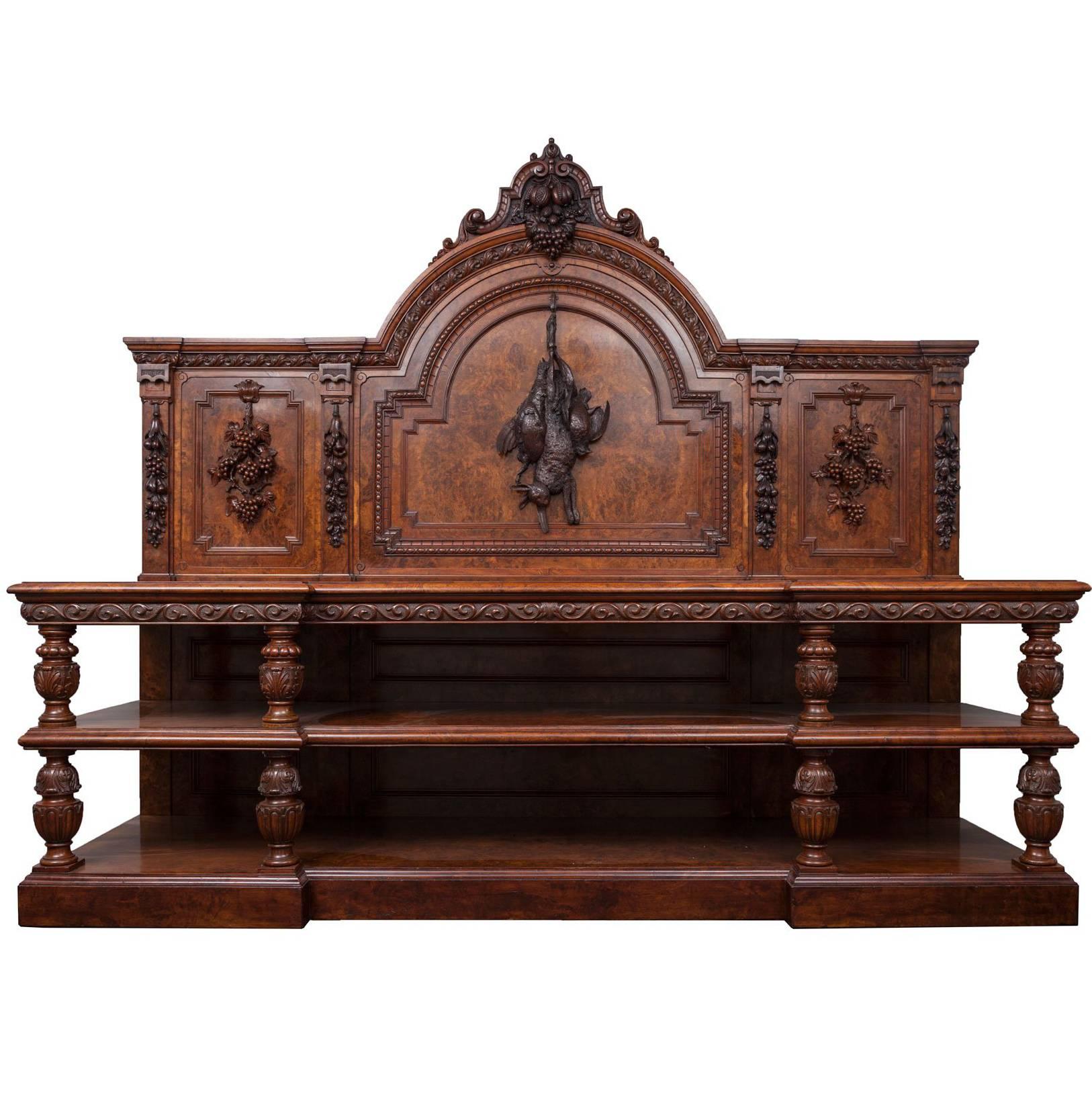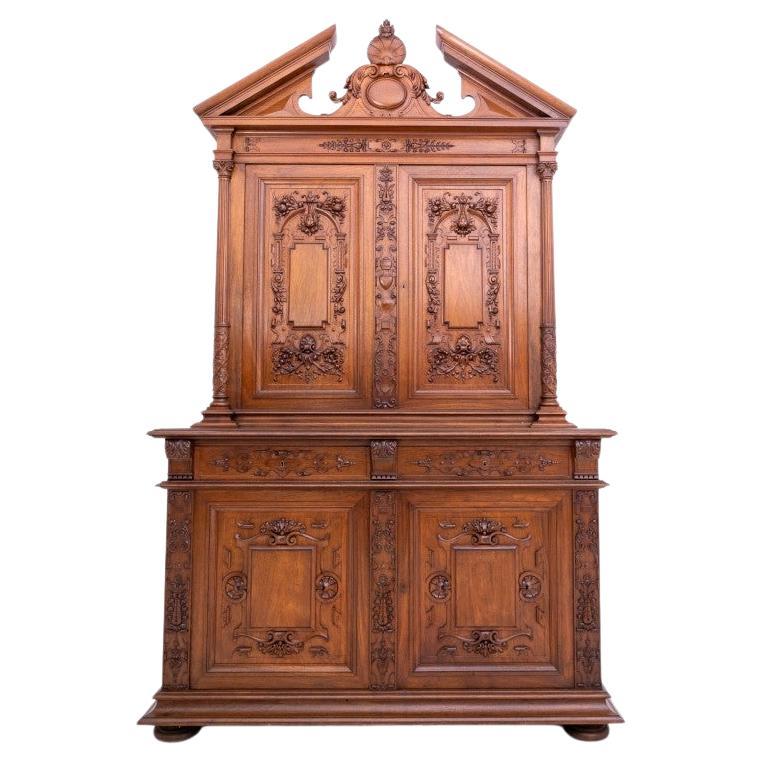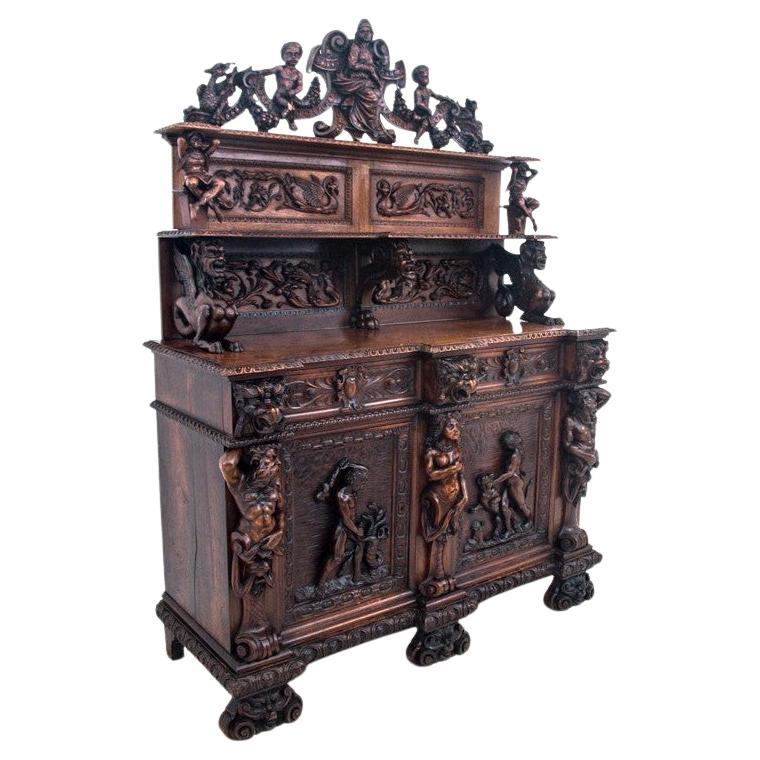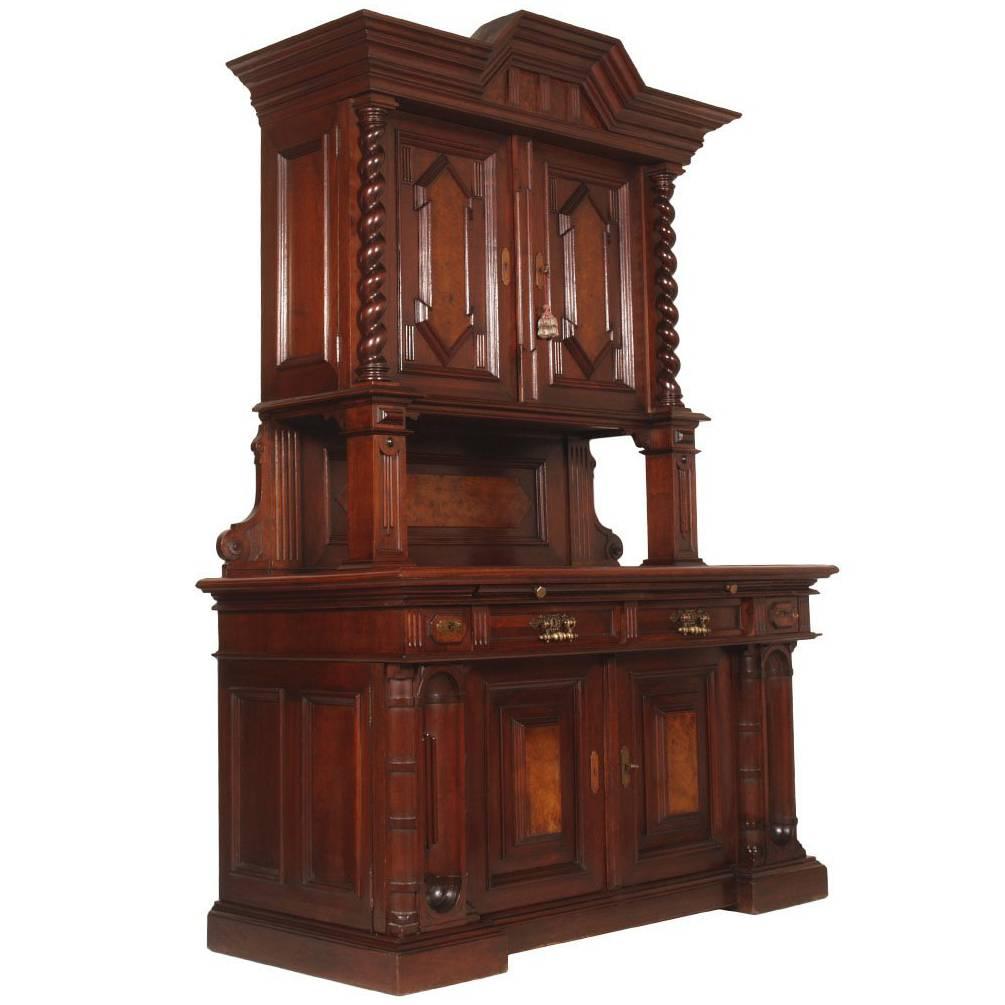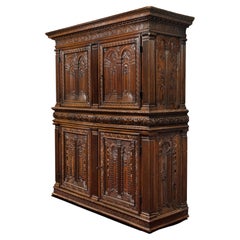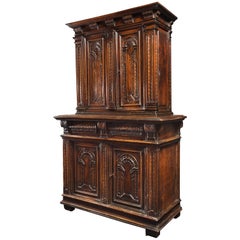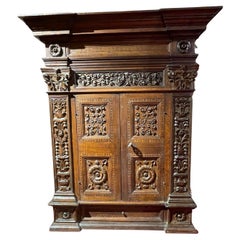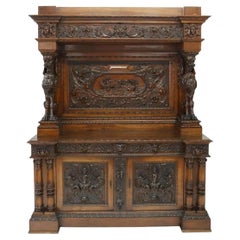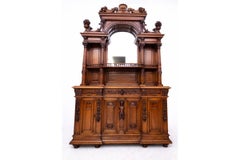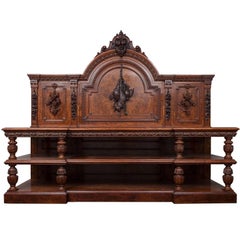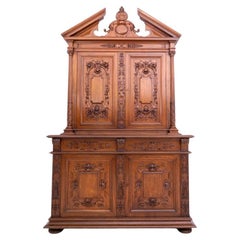Items Similar to Rare Italian Renaissance Perspectives Sideboard with Fan-shaped Pedestal
Want more images or videos?
Request additional images or videos from the seller
1 of 6
Rare Italian Renaissance Perspectives Sideboard with Fan-shaped Pedestal
$177,325.25
£131,982.65
€148,000
CA$242,891.26
A$270,148.10
CHF 141,062.95
MX$3,287,415.08
NOK 1,801,589.08
SEK 1,689,572.72
DKK 1,126,672.33
Shipping
Retrieving quote...The 1stDibs Promise:
Authenticity Guarantee,
Money-Back Guarantee,
24-Hour Cancellation
About the Item
RARE ITALIAN RENAISSANCE PERSPECTIVES SIDEBOARD WITH FAN-SHAPED PEDESTAL
ORIGIN: TUSCANY, FLORENCE
PERIOD: 16th CENTURY
Height : 143.5 cm
Length : 133 cm
Depth : 54 cm
Light coloured Walnut
This beautiful and very rare dresser of the Italian Renaissance opens with two doors decorated with carved low-relief perspectives and two drawers. It rests on a fan-shaped base. It superimposes two independent bodies. Four hanging spinning tops along the uprights complete the upper body echoing the four spinning tops resting on the base.
In the 15th century, the major interest for architecture on the one hand and for studies on perspective developed in 1457, carried out by the great Florentine architect Alberti on the other hand, enhance the taste of patrons for these disciplines.
The use of the designs and architecturally carved panels were propagated until the first years of the 16th century. The effect of the perspective, the sense of the depth, are already very prominent.
Making use of discoveries of the masters of perspective, this italien piece of furniture, of Florentine origin with motives of the urban views, creates an astonishing reflection of the architecture of it’s time.
The architectural views are various and recall some times Bramante, Venise, or Florence. Every city became a particular case of imaginary architecture.
This unusual construction of furniture, rare and unique, certainly took place in one of the most beautiful palaces in northern Italy. The use of the dresser was reserved for the presentation of silverware.
- Dimensions:Height: 56.5 in (143.5 cm)Width: 52.37 in (133 cm)Depth: 21.26 in (54 cm)
- Materials and Techniques:
- Period:
- Date of Manufacture:16th Century
- Condition:Repaired.
- Seller Location:Saint-Ouen, FR
- Reference Number:1stDibs: LU3115332453212
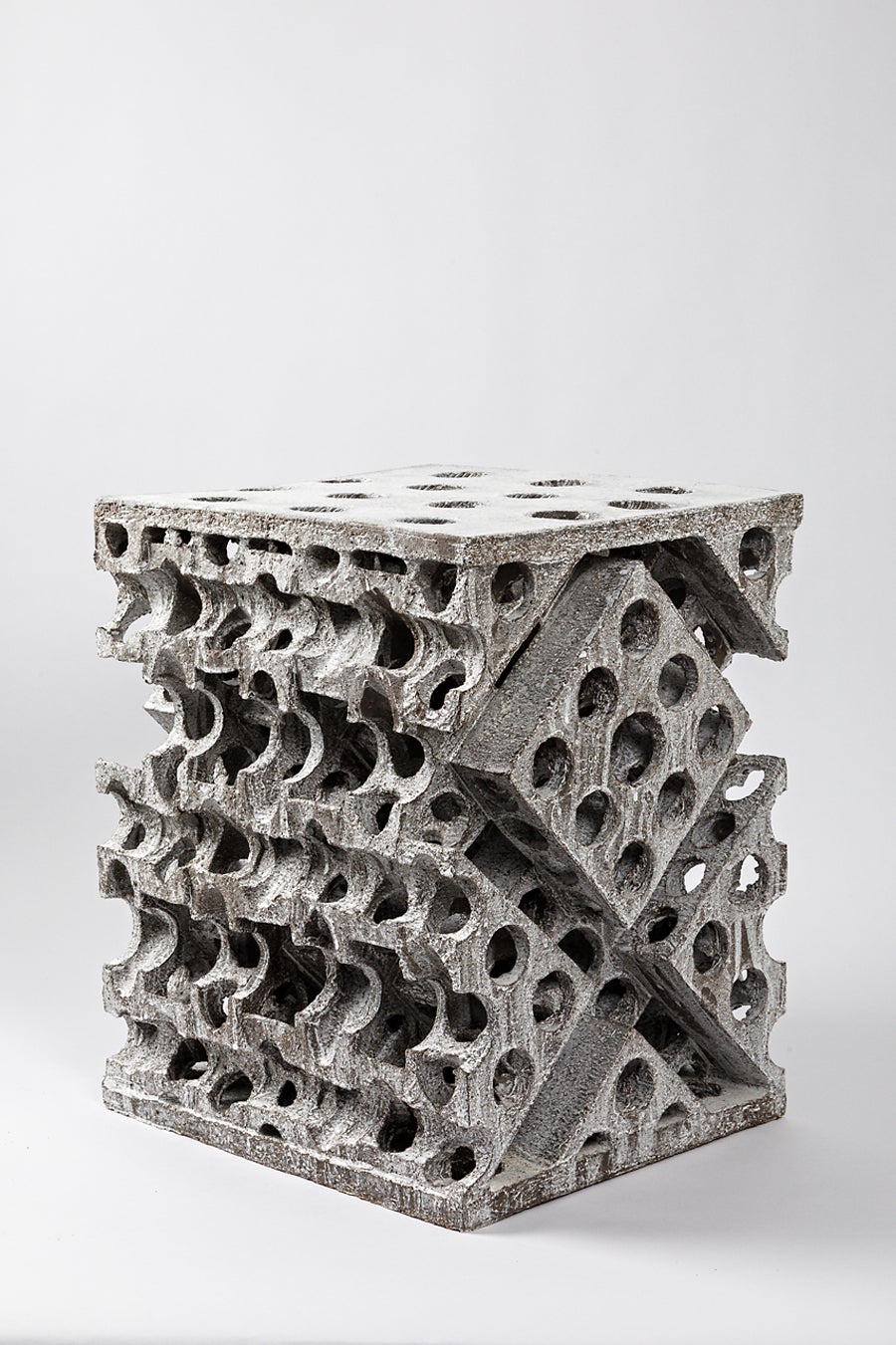
About the Seller
5.0
Vetted Professional Seller
Every seller passes strict standards for authenticity and reliability
Established in 2016
1stDibs seller since 2017
189 sales on 1stDibs
Typical response time: 3 hours
- ShippingRetrieving quote...Shipping from: Paris, France
- Return Policy
Authenticity Guarantee
In the unlikely event there’s an issue with an item’s authenticity, contact us within 1 year for a full refund. DetailsMoney-Back Guarantee
If your item is not as described, is damaged in transit, or does not arrive, contact us within 7 days for a full refund. Details24-Hour Cancellation
You have a 24-hour grace period in which to reconsider your purchase, with no questions asked.Vetted Professional Sellers
Our world-class sellers must adhere to strict standards for service and quality, maintaining the integrity of our listings.Price-Match Guarantee
If you find that a seller listed the same item for a lower price elsewhere, we’ll match it.Trusted Global Delivery
Our best-in-class carrier network provides specialized shipping options worldwide, including custom delivery.More From This Seller
View AllImportant Renaissance Cabinet from Lyon 'France' with a Decor of Perspectives
Located in Saint-Ouen, FR
As soon as 1540 France's second Renaissance is in the making, intimately linked to the rediscovery of the Antique world. The development of the printing and engraving industry allows the spread of artworks and models in many cities and countries. The Italian influence can be perceived in every artistic field. While the French king entrust the most talented Italian artists with major projects such as Il Rosso or Primaticcio in Fontainebleau, French artists also travel to Italy to form themselves to this new style. In Italy they get acquainted with the work of Leo Battista Alberti the first to theorize perspective (De Pictura, 1435-36) and architecture (De re oedificatoria, 1541). Those two publications would have a revolutionary impact on arts.
Furniture is marked by the work of the most famous Italian architects of the time as well as French architects. Indeed Philibert de l'Orme competes with Alberti and by the end of his life publishes several treaties including one devoted to a theory of architecture (1567). Unfortunately he would not live to complete the second volume. In this treaty he expresses his interest for mathematical norms applied to architecture, copied from the Antique. His journeys in Italy allowed him to accumulate the most sophisticated references. Jean Bullant, another architect of great talent also theorizes his practice. He establishes rules characterizing Greco-Roman art staying faithful to Vitruvius.
Following this new inspiration the structure of furniture evolves. From then on appear columns, capitals, cornices, friezes and architraves. The ornamentation uses this inspiration as well with egg-and-dart, palm leaf and rose adorning the most beautiful pieces.
In Lyon, crossroad where meet merchants from everywhere those new experiments are welcomed. Lyon florishing printing industry allows the spreading of models and treaties essential to the artist's work. Thus the first publication of Vitruvius' De Architectura in France would be printed in Lyon in 1532.
Artists from Lyon rediscover and familiarize themselves with the Antique knowledge very early. They adopt those new ideas and use them in their own creations. Lyon cabinet-makers re interpret Antique architecture and Italian Renaissance palaces to give their pieces a pure and harmonious architectural structure. Grooved pilasters are particularly favored. They are topped by capitals of diverse orders always respecting the sequencing with simpler ones for the lower levels and the richest ones on the higher levels. As for the ornamentation, one of the great distinctiveness of Lyon workshops remains the architectural perspective illusions, drawing inspiration from Tuscany.
True masterpiece of the Second French Renaissance this important cabinet illustrates Lyon workshops' taste for fine Italian architecture inspired by Antiquity. An architectural perspective of great quality is treated in symmetry on each panel.
This two-bodied cabinet without recess stands on four rectangular feet. The base comprises a molding, a palm leaf frieze and is bordered by a braid.
The lower body is divided by three grooved pilasters with Tuscan capitals framing two door-leaves. The two panels are encircled by a moudled frame with palm leaves. They are finely carved with a decor of fantasized architecture depicting an Italian Renaissance palace erected symmetrically on each side of a grooved pilaster. On the ground floor a door opens through a stilted arch while the stories are opened with mullioned windows, dormers and occuli. Two large pegged-boss cladded pillars support the entablature enriched by a palm leaf frieze upon which stands an arch whose coffered intrados is centred by a rose. Behind this arch a pyramid appears, standing in front of a second facade with a window topped by a broken curvilinear pediment under a cul-de-four with a shell.
The checker flooring gives depth to the low-reliefs creating vanishing points structuring the panels and guiding the eye of the observer.
A thin laurel braid highlights the belt of the cabinet where are located two drawers. Their facades are adorned by palm leaves in hoops.
The upper body is encircled with palm leaves. The same ternary division as in the lower body appears. However, the pilasters are topped by Ionic capitals with volutes and egg-and-dart. The door-leaves are framed with flowers. On the panels the artist has designed another architectural decor. On the foreground open two arches on top of grooved pilasters with rectangular capitals adorned with palm leaves. The arches are enriched with braids and the coffered intrados bears a decor of roses. The spandrels also bear a flower decor. In the background another arcature hosts a fluted grooved column topped with double basket acanthus capital, characteristic of Corinthian order. The triangular pediment is interrupted by a choux bourguignon.
A large cornice crowns the cabinet. It stands on pilasters and forms an entablature comprising a palm leaf frieze and an egg-and-dart, triglyph and palm leaf cornice.
The cabinet's sides have also been carefully considered. The lower body's panels are enriched with an arch rising above a broken pediment portico hosting a twisted column. Flowers garnish the spandrels. An architectural facade completes the decor. The upper body's panels present two arches supported by a facade opened with dormers and mullioned windows as well as cartouches (one bears the inscription 1580 dating the cabinet) suggesting the interior of an Italian Renaissance palace, confirmed by the chandeliers. The flooring leads our gaze to a second arch with a broken curvilinear pediment where stands a flower vase. This arch opens onto a perspective of another facade along a road.
Inside the cabinet, on the lower body door-leaves appear two designs. On the right door is depicted a Crucifixion. Saint Mary and Saint John flank the Christ on the cross. In the bottom part is inscribed « Dure uiator abis nihil haec spectacula curas / Pendenti cum sis unica cura Deo. / Tota suo moriente dolet natura Magistro. / Nil qui solus eras caussa dolenda doles. ». The signature [Christoff Swartz Monachiensis pinx[it] / Ioa[nnes] Sadeler sculp[it]] tells us it was made by Johan Sadeler I (1550-1600) after Christoph Schwartz (1548-1592). This engraving belongs to an ensemble depicting the Passion of Christ Johan Sadeler executed in 1589 after an altar piece painted by Christoph Schwartz for the private chapel of Renée of Loraine, wife of Duke William V of Bavaria. This altar piece made of nine copper panels has been destroyed during the 19th century. The Crucifixion panel once in the centre of the altar piece is the only one that survived and is today kept in Munich's Alte Pinakothek.
On the left door appears Saint Francis receiving the stigmata. The inscription says : « Signastidomine Servum Tuum. Franciscum. Signis Redemptionis Nostrae ».
This Renaissance cabinet with an architectural decor appearing as much in the structure faithful to Antique rules...
Category
Antique 16th Century European Renaissance Cabinets
Materials
Walnut
French Renaissance Cabinet with Perspectives
Located in Saint-Ouen, FR
This Renaissance Cabinet reveals the great mastery of the Lyon workshops which are at the origin of its realization. Sculptors and wood-carvers worked here in symbiosis to express an...
Category
Antique 16th Century French Renaissance Cabinets
Materials
Walnut
Rare Renaissance Florentine Cabinet with Certosina Decoration
Located in Saint-Ouen, FR
RARE RENAISSANCE FLORENTINE WALNUT CABINET WITH CERTOSINA DECORATION
ORIGIN: FLORENCE, ITALY
PERIOD: END OF 15th CENTURY – BEGINNING OF 16th CENTURY
Height: 129 cm
Length: 107 cm...
Category
Antique 16th Century Cabinets
Materials
Walnut
16th Century French Walnut Cabinet with Marble Inlays
Located in Saint-Ouen, FR
On the left post of the lower body, is written the date 1596 in a cartouche
This cabinet has two bodies. The upper part, set back, is moulded and carved. At the bottom, the cabine...
Category
Antique 16th Century French Renaissance Cabinets
Materials
Walnut
Rare Renaissance Dresser with Marquetry and Pastiglia, from Alsace 'France'
Located in Saint-Ouen, FR
This sideboard, with rich marquetry decoration, consists of two parts. The decorated upper body allows for the display of fine silverware. Superb carve...
Category
Antique Early 17th Century French Renaissance Dressers
Materials
Walnut
Renaissance Cabinet form Lyon 'France'
Located in Saint-Ouen, FR
Condition : Partly dating from the Renaissance. The backs and the drawer’s insides have been re-done.
Historical background
The 16th century is a prosperous period for Lyon...
Category
Antique 16th Century French Renaissance Cabinets
Materials
Walnut
You May Also Like
1800s Antique Italian Renaissance Revival, Exceptional, Foliates Sideboard!!
Located in Austin, TX
Exceptional Antique Sideboard, Italian Renaissance Revival, Carved Wood, Foliates, Masks, Late 19th century, 1800s, 19th century!
Monumental Italian Renaissance Revival carved sideb...
Category
Antique 19th Century Italian Renaissance Revival Sideboards
Materials
Wood
Exceptional figural sideboard, France, ca. 1880.
Located in Chorzów, PL
Exceptional figural sideboard, France, ca. 1880.
Very good condition.
Wood: walnut
Dimensions: height 287 cm width 180 cm depth 60 cm
Category
Antique Late 19th Century French Renaissance Cabinets
Materials
Glass, Walnut
Large Antique Sideboard
Located in Tyrone, Northern Ireland
Large antique pollard oak sideboard of exceptional quality and great architecture form.
This wonderful sideboard, server or buffet boasts exquisitely carved elements and eye-catching pollard oak veneers. The arch topped back is carved with a hunt trophy depicting a hare, pheasant and grouse. At either side are two pilasters carved with summers fruits and centred by panels of abundant grapevines. The deep breakfront shelves...
Category
Antique Mid-19th Century Irish Renaissance Revival Sideboards
Materials
Oak
$47,964
Majestic sideboard, France, ca. 1880.
Located in Chorzów, PL
Majestic sideboard, France, ca. 1880.
Very good condition.
Wood: walnut
Dimensions: height 295 cm width 183 cm depth 65 cm
Category
Antique Late 19th Century French Renaissance Cabinets
Materials
Glass, Walnut
Renaissance sideboard, France, circa 1790.
Located in Chorzów, PL
An old sideboard - chest of drawers with a top in the Renaissance style. Made in the late 18th century from walnut wood. A unique piece of furniture, richly decorated with carvings a...
Category
Antique Late 18th Century French Renaissance Cupboards
Materials
Walnut
18th Century Important Tuscany Renaissance Sideboard Credenza, in Solid Walnut
Located in Vigonza, Padua
Code: FR45
Antique Tuscany heavy and massive sideboard in solid walnut. In two parts: the top with two doors and two internal shelves with spiral wal...
Category
Antique Mid-18th Century Italian Renaissance Sideboards
Materials
Walnut
More Ways To Browse
Antique Fans
Fan Light
Rare Sideboard
Italian Fan
Pedestal With Storage
Antique Hand Fans
Italian Renaissance Architecture
Italian Renaissance Light
Antique Architect Cabinet
Italian Renaissance Doors
Hand Fans Italy
Italian Renaissance 15th Century
Silverware Cabinet
Unusual Sideboard
Silverware Storage Cabinets
16th Century Carved Panel
Case Study Dresser
Pedestal Sideboard
